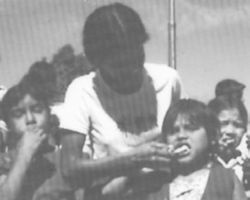Hesperian Health Guides
Part 1: Teaching So Learning Can Take Place
HealthWiki > Where There Is No Dentist > Chapter 3: Teaching Children at School > Part 1: Teaching So Learning Can Take Place

More children than ever before are having problems with their teeth and their gums.
A tooth that hurts or gums that are sore can affect a student’s ability to pay attention in school and learn.
Treating the problem makes the child feel better, and that is important. It is equally important to prevent the same problem from returning later.
Working together, teachers and school children can do much to prevent both tooth decay and gum disease.
Keeping the mouth healthy involves learning about eating nutritious food and keeping teeth clean. Just giving information is not enough, though. To truly learn, children need a chance to find out things for themselves.

Forcing a person simply to accept what you say does not work very well.
A student learns not to question. What you teach may have no relation to his own experiences and needs.

As a result, he may end up not doing what you teach — not eating nutritious foods, and not cleaning his teeth.
Learning happens when a student with a question or an idea is able to discover more about it himself.
It also happens when he has a chance to do whatever is necessary to take better care of himself and his family.
He can learn by doing. Give him a chance to eat nutritious food and clean his teeth at school.
Learning about teeth and gums can be fun. When the teaching is real and practical, students love to learn. Here are some ideas:
Contents
1. Teach and learn together with school children


that happens,
Vincent?
rotten.
tooth.
tooth
loose!
A discussion draws out information and opinions.
It helps you to learn more about the school children, what they already know and believe to be true.
But it also allows you to introduce important information that is related to the discussion.2. Start with what the students already know
Add information by building upon what a person already knows.
Do not use big words. Scientific names and textbook explanations are confusing, and you usually do not need them. Talk about teeth and gums using words that a school child can understand and use later at home.

This way makes students feel stupid.
| This way helps more students to understand because it uses words and ideas they already know. |
What mouth parts help you to chew and swallow?
The teeth!
The tongue!
Spit! |
When you can understand new information, you gain confidence and you look forward to learning more.
3. Let students see and do
Students learn best when they can take part and find out for themselves about something new.

Giving a lecture on how to make a toothbrush and use it to care for teeth is a start ("See one"). But many people don't remember much of the information they are taught this way.
When a person makes their own toothbrush and cleans their teeth with someone who knows how ("Do one"), this is more interesting and fun. And doing it themselves makes it easier to remember.
When that person then shows someone else ("Teach one"), that information becomes a part of them. And by sharing this information, they can support others to care for their health.
4. Let children help each other

- When they feed the younger children, they can encourage them to eat nutritious food, like fruit instead of candy.
- They can do a play or puppet show about care of teeth and gums.
- They can check the teeth and gums of the younger children and "score" them on how healthy they are.
- Best of all, they can actually clean the teeth of the younger ones, and show them how to clean their own teeth when they are able.
5. Teach about teeth and gums together with other subjects
Eating nutritious food can be part of a discussion on nutrition, teeth, farming methods, and the politics of who owns the lands.

Cleaning the teeth can be part of a discussion on hygiene, clean water, and traditions and customs.
A good way for school children to learn about using numbers is to do a survey in the community.
The results will tell the children something about health problems in their community. For an example of a survey of health problems, see page 3‑14 of Helping Health Workers Learn.
See more ideas on how school children can help each other at Child to Child, Institute of Education.6. Be a good example
Children watch people around them. They pay attention to what you do, as well as to what you say.

Be a good example. Take care to do yourself what you are teaching to your students.
Your family can be a good example for others.
- Clean your teeth carefully every day. Also, help your children keep their teeth clean.
- Make a garden near your house and plant a variety of vegetables and fruits in it.
- Buy only healthy food from the store. Do not buy sweet foods and drinks for yourself or your children.
7. Make the community part of your classroom
A child’s home and his community are really more important to him than his school. Learning will be more interesting for a student if the day-to-day needs of his home and his community are part of school discussion.

Let students find out more about problems at home and in their community.
For example:
- How many small children have cavities or red, bleeding gums?
- How many stores have mostly sweet snack foods on their shelves?
- Why do the people not grow and eat more local food?
Back in the classroom, students can record what they find. Ask the children to think of ways to solve the problems they found. If they can think of a program to help solve a health problem, let them go back into their community and try it.



